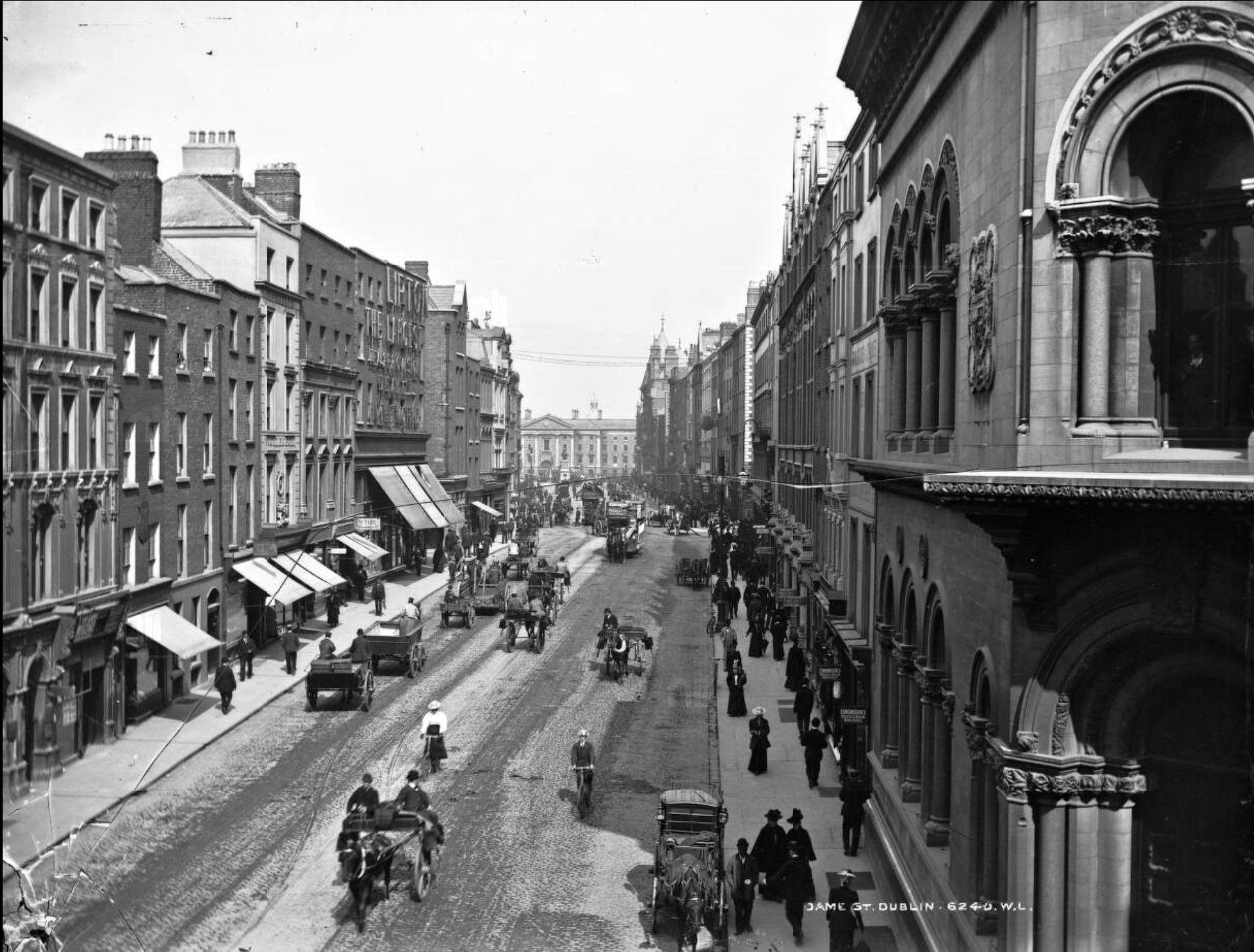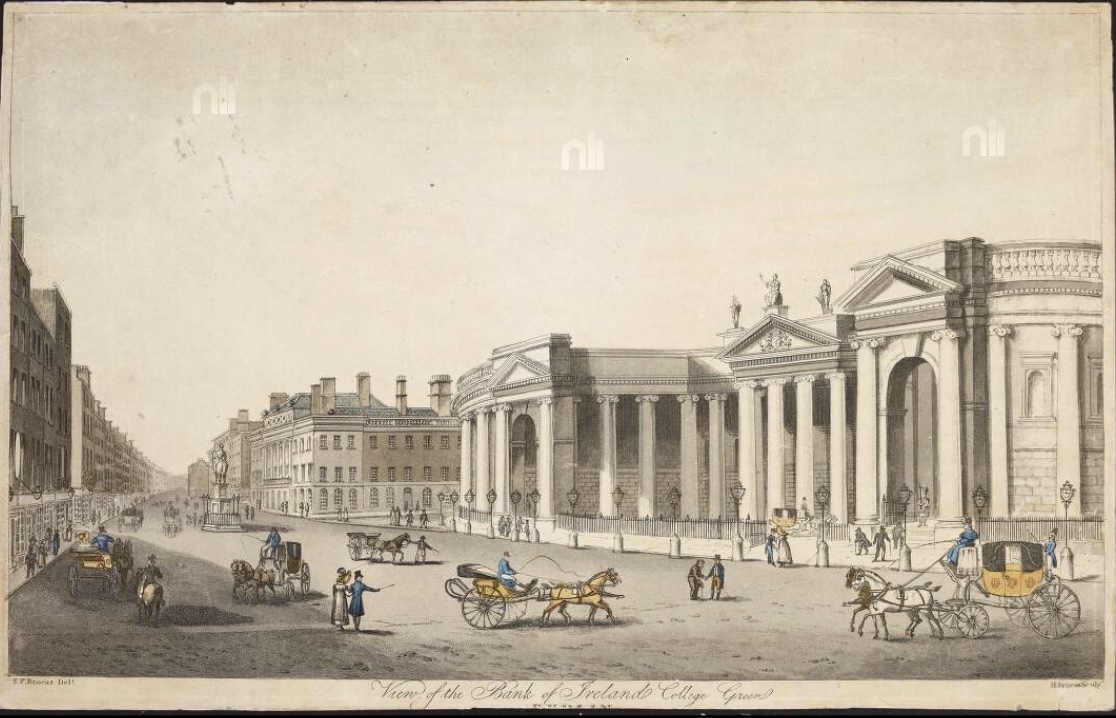Nestled in the heart of Dublin, Dame Street stands as a testament to the city’s rich history, captivating its inhabitants and visitors alike. From its medieval origins to its modern-day vibrancy, Dame Street has witnessed an extraordinary transformation, bearing witness to the city’s triumph, turmoil, and resilience.

Dame Street’s origins can be traced back to the medieval era, when it was known as “the street of Theng-Mote,” referencing a gathering place for the city’s council meetings. The name is thought to have derived from the Norse word “thingmoot,” which means “the place of the assembly.” Theng-mote was the site of the city’s council meetings and a gathering place for the Vikings who ruled Dublin in the 10th and 11th centuries.
The street was situated in the southeastern corner of the Viking town, just inside the city walls. It was a bustling thoroughfare, lined with timber-framed houses, shops, and taverns. The Vikings who controlled Dublin were a mix of traders, warriors, and craftsmen, and Theng-mote was a hub of activity for them.
Later, the Dominican Order established a priory, known as St. Mary del Dame, which played a pivotal role in shaping the street’s identity.

As the Elizabethan era dawned, Dame Street underwent a significant transformation. Richard Boyle, 1st Earl of Cork, acquired the land surrounding St. Mary del Dame and constructed Cork House, a grand mansion that would become a defining feature of the street. In honor of Boyle’s wife, Elizabeth, the street was renamed “Dame Street,” a name it has proudly carried ever since.
18th and 19th Centuries: Dame Street’s Golden Age
During the 18th and 19th centuries, Dame Street flourished as Dublin’s commercial and social hub. Elegant Georgian buildings lined the street, housing banks, insurance companies, and fashionable shops. Dame Street became a vibrant meeting place, where merchants, politicians, and socialites mingled, creating a lively atmosphere.
The street boasts an impressive collection of architectural gems, each with its own fascinating story to tell. The City Hall, a magnificent Beaux-Arts structure, stands as a symbol of civic pride. The Bank of Ireland, once the Parliament House, echoes with whispers of political debates and historic decisions. The Gandon Memorial, an ornate tribute to architect James Gandon, serves as a reminder of the city’s architectural heritage.
Dame Street in Literature: Immortalized in Irish Words
Dame Street has inspired countless literary works, gracing the pages of novels and poems. James Joyce’s “Ulysses” vividly captures the street’s vibrant atmosphere, while Brendan Behan’s “Borstal Boy” paints a poignant portrayal of the street’s darker side. Dame Street has become an indelible part of Dublin’s literary landscape.
In James Joyce’s “Ulysses,” the character of Leopold Bloom walks down Dame Street and muses on the different ways people perceive the world. The quote is as follows:
“All, to his knowledge, must somehow pass Dame Street. He watched from the steps. His mind filled slowly with an intricate design of casual threads. First came medical students with their skulls: then came a hurrying crowd like flies at a sugar lump: then an old woman, a bag bulging at her side: then two youths: then a redheaded girl. Each character as it passed drew a question in a speech mark. Why? Where going? Who? When? How much? To this hour? For what purpose? Was that intelligible? All that! Each answer would set another. Why go to Loreto College? To learn, you might say. Where are they going from Loreto College? Home. For what purpose? To eat, sleep, study or play. Who is eating this potato chip? A workingman on his way home. Is it one of those on the building? You might say so.”
Dame Street Today: A Dynamic Tapestry of Old and New
In the 21st century, Dame Street continues to evolve, retaining its historical charm while embracing modern trends. Trendy cafes, bustling bars, and international retailers coexist with traditional shops and heritage landmarks. Dame Street serves as a microcosm of Dublin’s dynamic nature, where the past harmonizes with the present.
Interesting Stories: Dame Street’s Anecdotes and Legends
Dame Street is a treasure trove of interesting stories and anecdotes. In 1800, Lord Edward Fitzgerald, a leader of the Irish Rebellion, was captured in a house on Dame Street, marking a pivotal moment in Irish history. The street has also witnessed numerous theatrical performances, political rallies, and public celebrations. Dame Street’s rich history is woven into the very fabric of its cobblestone streets.
Lord Edward Fitzgerald, a leader of the Irish Rebellion of 1798, was captured in a house on No. 15 Dame Street, Dublin, on May 19, 1798. The house was owned by a feather merchant named Nicholas Murphy. Fitzgerald had been hiding in the house for several weeks after the rebellion had been suppressed.
Here is an account of Fitzgerald’s capture from Thomas Moore’s biography of the Lord Edward Fitzgerald:
“About nine o’clock in the morning of the 19th of May, an officer and three soldiers proceeded to a house in Thomas Street, where they had received information that Fitzgerald was concealed. They found him in an upper room, concealed in a truss of hay. He attempted to defend himself, and wounded one of the soldiers mortally. But he was soon overpowered and secured.“
Fitzgerald was taken to Newgate Prison, where he died of his wounds on June 4, 1798.
Dame Street: A Street of Enduring Significance
Dame Street stands as a testament to Dublin’s enduring spirit, having witnessed eras of change, conflict, and progress. Its architecture, history, and literary resonance make it a beloved landmark, a symbol of the city’s resilience and vitality. As we stroll along Dame Street, we walk not just on a path but on a tapestry of time, a testament to Dublin’s remarkable story.
